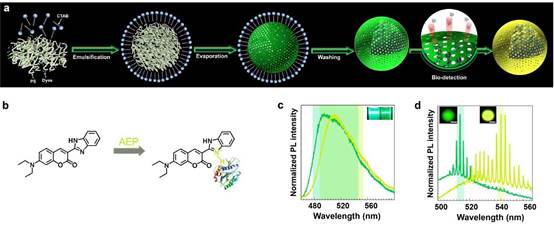Prof. Ruan Shuangchen, president of Shenzhen Technology University (SZTU) and Prof. Ning Cunzheng, distinguished professor of SZTU and dean of College of Integrated Circuits and Optoelectronic Chips, demonstrated a fundamentally new strategy for ultrasensitive detection based on color-switchable lasing with a cavity-enhanced reduction of limit of detection (LOD). The research results were published in the interdisciplinary premium journal Advanced Science (Q1, IF: 16.806) titled “Ultrasensitive Detection of Biomarkers in a Color-Switchable Microcavity-Reactor Laser”. Song Zongpeng, postdoctoral researcher, and Li Ran, engineer from the Analysis and Testing Center of SZTU, are the co-first authors. Prof. Zhu Haiou, Prof. Ning Cunzheng and Prof. Ruan Shuangchen are the co-corresponding authors, and SZTU is the first affiliation. The full text of the paper can be found at: https://onlinelibrary.wiley.com/doi/10.1002/advs.202202326.

a) Preparation of polystyrene sphere (PSS) samples and detection mechanism; b) Reaction mechanism of 3-(2-benzimidazolyl)-7-(diethylamino) coumarin (C7) with asparaginyl endopeptidase (AEP); c) photoluminescence (PL) spectra of C7 with (green) and without (cyan) AEP; d) C7+PSS with (green-yellow) and without (green) AEP. [Photo/Analysis and Testing Center]
This paper proposes a novel ultrasensitive detection approach based on microsphere cavities formed by bio-compatible polystyrene (PS) mixed with dyes, penetrated by biomarker molecules when submerged in the biomolecular solution. When biomarkers interact with the chemo-responsive dyes, intramolecular charge-transfer modifies the electronic structure of dyes, resulting in the shift of emission wavelengths, thereby realizing qualitative detection of biomarkers with the naked eyes. Due to the dramatic cavity enhancement, the strong photoluminescence (PL) signal results in the sensitive detection of much lower concentrations.
The approach will offer exciting future opportunities for biomedical detection and early diagnostics to reduce the mortality rate of fatal diseases with the following advantages compared with conventional methods: 1) The cavity-enhanced emission and lasing with only a single biomarker molecule per cavity allow improved visual distinguishability via color changes. 2) The large shifts require only an inexpensive spectrometer or a simple band filter to resolve and even allow determination by the naked eye. 3) When combined with a narrow-band filter, the color-switchable lasers act as an “on-off” logic signal and can be integrated into multiplexing detection assay biochips. 4) The simplicity of the approach can make it easier to be used for ultrasensitive detection of many other biomarkers. 5) It is in vivo compatible.
Drafted by Daisy(姚琦)/ International Cooperation & Student Affairs Office
Revised by International Cooperation & Student Affairs Office
Edited by International Cooperation & Student Affairs Office
